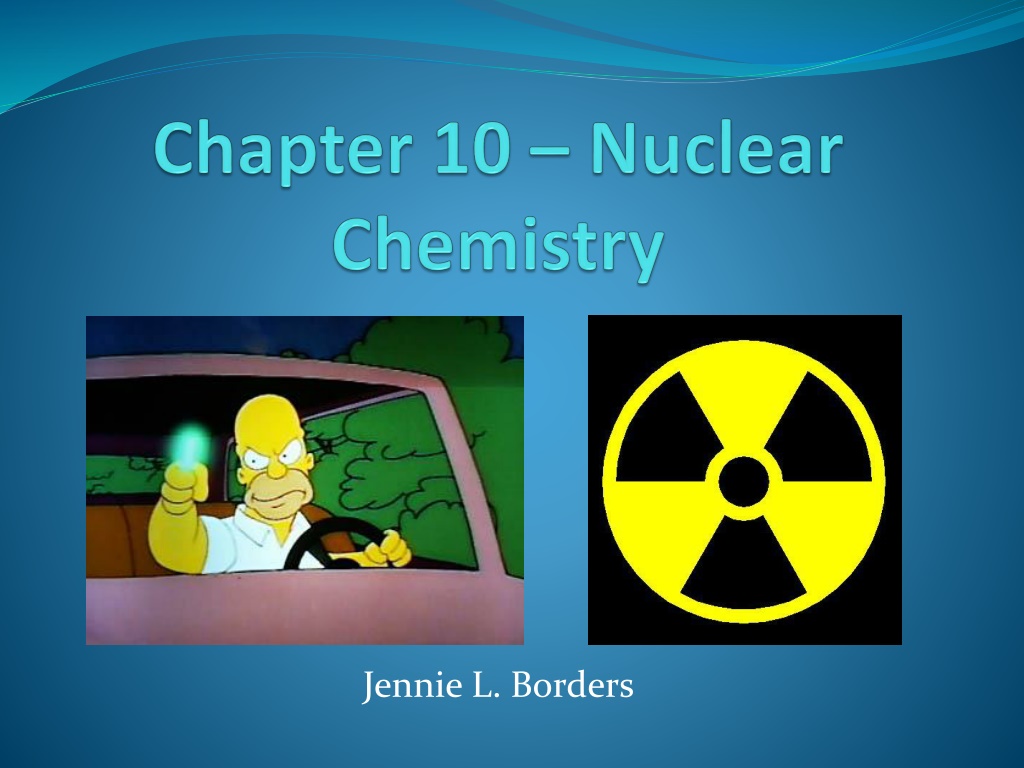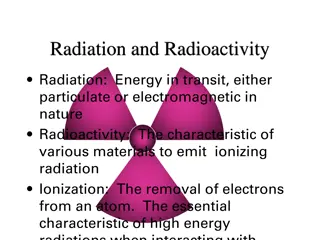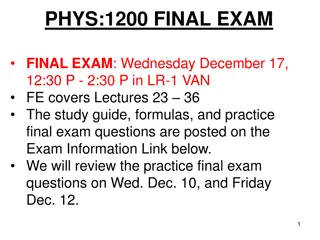Understanding Radioactive Decay and Nuclear Radiation
Radioactive decay is the process in which unstable atomic nuclei emit charged particles and energy, transforming into different elements. This process involves the emission of alpha particles, beta particles, and gamma rays. Alpha particles consist of two protons and two neutrons, beta particles are electrons emitted by unstable nuclei, and gamma rays are penetrating energy emissions. Each type of radiation affects atomic and mass numbers differently, leading to the formation of new elements. Understanding the properties and implications of nuclear radiation is crucial in various scientific and industrial fields.
Download Presentation

Please find below an Image/Link to download the presentation.
The content on the website is provided AS IS for your information and personal use only. It may not be sold, licensed, or shared on other websites without obtaining consent from the author. Download presentation by click this link. If you encounter any issues during the download, it is possible that the publisher has removed the file from their server.
E N D
Presentation Transcript
Radioactivity is the process in which an unstable atomic nucleus emits charged particles and energy. Any atom containing an unstable nucleus is called a radioactive isotope, or radioisotope for short. During nuclear decay, atoms of one element can change into atoms of a different element all together.
Nuclear radiation is charged particles and energy that are emitted from the nuclei of radioisotopes. Common types of nuclear radiation include alpha particles, beta particles, and gamma rays.
An alpha particle (a) is a positively charged particle made up of two protons and two neutrons the same as a helium nucleus. It has a +2 charge and the common symbol for the alpha particle is 4 2He. Alpha particles are the least penetrating type of nuclear radiation. ____
238 92U 234 90Th + 4 2He In the equation above, the mass number on the left (238) equals the sum of the mass numbers on the right (234 + 4). Also, the atomic number on the left (92) equals the sum of the atomic numbers on the right (90 + 2).
A beta particle (b) is an electron emitted by an unstable nucleus. In nuclear reactions, a beta particle is written as 0 -1e and it has a charge of -1. During a beta decay, a neutron decomposes into a proton and an electron. The proton stays trapped in the nucleus while the electron is released. ___
234 90Th 234 91Pa + 0 -1e Again the mass numbers and the atomic numbers are the same on both sides of the equation. Beta particles are more penetrating than alpha particles.
A gamma ray (g) is a penetrating ray of energy emitted by an unstable nucleus. Gamma radiation has no mass and no charge. During gamma radiation, the atomic number and mass number of the atom remain the same, but the energy of the nucleus decreases. It often accompanies alpha or beta decay.
-1e + g 234 90Th 234 91Pa + 0 Gamma rays are more penetrating than either alpha or beta particles.
Radiation Type alpha beta gamma Abbreviation Symbol Charge Mass a b g 42He 0-1e g +2 -1 0 4 0 0
Write a balanced nuclear equation for the alpha decay of polonium 210. 210 84Po 4 2He + 206 82Pb
Write a balanced nuclear equation for the alpha decay of thorium 232. 1. 232 90Th 4 2He + 228 88Ra 2. Write a balanced nuclear equation for the beta decay of carbon 14. 14 6C 0 -1e + 14 7N
3. What type of decay is in the following reaction? 241 95Am 237 93Np + ? ? = 4 2He decay = alpha 4. What type of decay is in the following reaction? 90 38Sr 90 39Y + ? ? = 0 -1e decay = beta
Nuclear radiation that occurs naturally in the environment is called background radiation. When nuclear radiation exceeds background levels, it can damage the cells and tissues of your body. Nuclear radiation can ionize atoms.
Devices that are used to detect nuclear radiation include Geiger counters and film badges.
How does an element change during nuclear decay? 2. What are three types of nuclear radiation? 3. How are atoms affected by nuclear radiation? 4. What devices can be used to detect nuclear radiation? 5. How do types of nuclear radiation differ in electric charge? 6. Describe the penetrating power of each common type of radiation. 1.
7. What is background radiation? 8. What is the effect of beta decay on the composition of the nucleus? 9. Write the balanced nuclear equation for the alpha decay of radium 226. 226 88Ra 4 2He + 222 86Rn 10. Fill in the reactant for the following nuclear reaction. ? 3 ? = 3 2He + 0 -1e 1H
Every radioisotope decays at a specific rate that can be expressed as a half-life. A half-life is the time required for one half of a sample of a radioisotope to decay. After one half-life, half of the atoms in a radioactive sample have decayed, while the other half remain unchanged.
Unlike chemical reaction rates, which vary with the conditions of a reaction, nuclear decay rates are constant. To calculate the half-lives, you use the following formula. # of half lives = total time of decay half-life
Suppose you have a 1 gram sample of iridium 182, which undergoes beta decay with a half-life of 15 minutes. After 45 minutes, how much iridium 182 will remain in the sample? # of half- lives = Total time of decay = 45 min. = 3 half-life 15 min. 1g = 0.5g = 0.25g = 0.125g 2 2 2
In radiocarbon dating, the age of an object is determined by comparing the object s carbon-14 levels with carbon-14 levels in the atmosphere. Because atmospheric levels of carbon-14 can change over time, the calculated age of a fossil is not totally accurate.
To get a more accurate radiocarbon date, scientists compare the carbon-14 levels in a sample to carbon-14 levels in objects of known age. Objects older than 50,000 years contain too little carbon-14 to be measureable.
How are nuclear decay rates different from chemical reaction rates? 2. How can scientists determine the age of an object that contains carbon-14? 3. If a radioactive sample has decayed until only one eighth of the original sample remains unchanged, how many half-lives have elapsed? 1. 1 x 1 x 1 = 1 3 half lives have passed 2 2 2 8
4. Can radiocarbon dating be used to determine the age of dinosaur fossils? 5. A certain isotope of technicium has a half-life of six hours. If it is given to a patient as part of a medical procedure, what fraction of the radioisotope remains in the body after one day? 24 hr. = 4 half-lives 1 x 1 x 1 x 1 = 1 6 hr. 2 2 2 2 16
Warm-Up Apr. 22 1. What is half-life? 2. What is the formula for calculating how many half-lives have passed? 3. If you start with 50g of a radioisotope that has a half-life of 2 hours, how much of the sample would be left after 4 hours?
Nuclear energy is energy released by nuclear reactions. The strong nuclear force is the attractive force that binds protons and neutrons together in the nucleus. Over very short distances, the strong nuclear force is much greater than the electric forces among protons.
The greater the number of protons in a nucleus, the greater the electric force that repels those protons. All nuclei with more than 83 protons are radioactive.
Fission is the splitting of an atomic nucleus into two smaller parts. In nuclear fission, tremendous amounts of energy can be produced from very small amounts of mass.
Fusion is a process in which the nuclei of two atoms combine to form a larger nucleus. As in fission, during fusion a small fraction of the reactant mass is converted to energy. The sun and other stars are powered by the fusion of hydrogen into helium.
Fusion requires extremely high temperatures. Plasma is a state of matter in which atoms have been stripped of their electrons.
Under what conditions does the strong nuclear force overcome the repulsive effect of electric forces in the nucleus? 2. What property of fission makes it a useful reaction? 3. What particles are affected by strong nuclear forces? 4. How does the products of a fusion reaction differ from the products of a fission reaction? 1.























